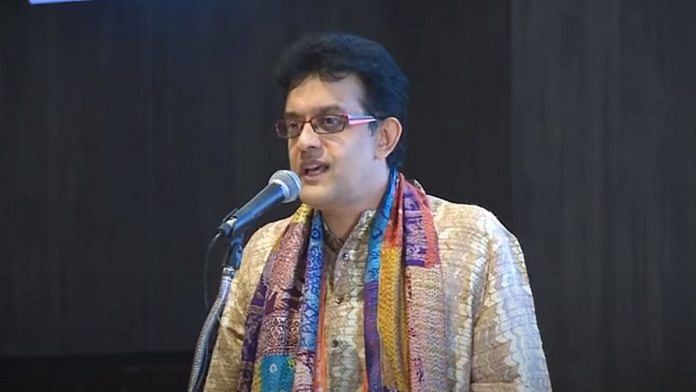New Delhi: The slow, meticulous and omniscient translator’s pen is getting an AI-themed reboot. And it’s coming from Vikram Sampath, the author of several bestselling books that are rooted in ‘indic’ history. Sampath is now the co-founder of NAAV AI, a startup that aims to infuse frenetic speed, functionality, and efficiency into the publishing industry through AI-generated translations.
“I am a published author and to get my books translated into Indian languages is a problem,” said Sampath. Frustration leaked from his voice as he explained how it could take 15-16 years for his work to be published in Kannada even though he lives in Bengaluru.
“And it’s not like there’s no demand or interest for good content in Indian languages. But the supply is unable to meet the demand,” said Sampath in conversation with ThePrint, alongside NAAV-AI co-founder Sandeep Singh Chauhan, an engineer who was a senior director in a multinational firm and has over 20 years of corporate experience.
NAAV-AI is backed by Ola founder Bhavish Aggarwal and venture capitalist Asha Jadeja. And it is, among other things, an attempt by Sampath and Chauhan to rid the publishing industry of a supposed all-consuming bias — the hegemony of the English language and the “linguistic barriers” that have become an indelible part of India’s literary discourse. The duo is using a combination of existing foundational AI models in order to churn out book translations in six Indian languages: Hindi, Kannada, Marathi, Tamil, Telugu, and Malayalam.
But there’s an obvious caveat. Existing AI models come with their fair share of biases, having sprung from Western-centric data sets. They are also prone to hallucinations.
“The current LLMs (Large Language Models) are trained enough to generate a decent translation from English to other languages. The first cut is decent but not good enough to be published,” he said, adding that when it comes to the “indic context,” there is an implicit bias, as the data fed into current LLMs are in English.
That’s when a much-needed human intermediary steps in. Despite the lofty claims of a tech-laden future suggesting otherwise, there is still no real replacement for human labour when it comes to the nuanced act of translation. NAAV-AI has also inducted “language experts” and teams of translators to augment the quality of the existing service. In effect, existing models such as Claude and ChatGPT provide a template.
“But not for large books, which span thousands of pages. There’s still a lot to be desired. The government realises this,” Chauhan said, suggesting that homegrown AI models will pick up the slack in the near future.
When it comes to literature, it’s important to approach AI with a degree of caution, said K Sreenivasarao, member secretary of the Sahitya Akademi.
“We have to be careful. For instance, poetry is so sensitive. Indian literature has its own Indian-ness, its proverbs, and even within Indian languages, it’s difficult to translate sometimes. Every word carries weight. The flavour isn’t there (in some translations). So how will AI work?”
But it is difficult to avoid AI entirely in the context of literary translations, Sreenivasarao added. It’s still necessary to “cater to the younger generation” for whom it is a part and parcel of life.
Why translations matter
For the first leg of NAAV-AI’s translations, Vikram Sampath has tapped into his network within the publishing industry. His first client is publisher Blue One Ink.
Apart from Sampath’s 2024 book Waiting for Shiva, Blue One Ink has also published Rajiv Malhotra’s Who is Raising Your Children and Utpal Kumar’s Eminent Distorians, which seeks to dismantle the “dominant historical narrative” aka the “Nehruvian lens.”
NAAV-AI has tackled three of Blue One Ink’s Young Adult books: Mega Cool Leaders of India, Missing Rocks of Hampi, and The Rise of Ancient Indians. The translations will be released next month.
Sampath and Chauhan consciously chose to venture into children’s books first.
“The language is simpler, the number of pages is fewer. We thought it would be a good start,” said Sampath.
There’s variance when it comes to language as well. AI is more equipped in translating certain languages. Hindi has the highest AI success rate, while Marathi has the lowest.
For Sampath and Chauhan, reach is of paramount importance. It’s the nuts and bolts of their start-up, along with maximising output. A book that used to take four months to translate can now be completed in a few weeks.
Sampath, whose works include a biography of Vinayak Damodar Savarkar and a book on Tipu Sultan — both in English — appears to have realised the limitations of sticking to one language in a country with a wealth of diversity.
“In our elitist bubble, we may think we’re doing something earth-shattering. But for good quality textual content to reach Indians, we need translations,” he said.
As part of their mission to generate more translated works, Chauhan and Sampath aim to launch their own content platform.
“People are consuming more content through the internet. We want to cater to the digital audience as well. It’s like a Netflix for audio,” said Chauhan. “We want to have more and more content, and support Indian languages.”
This content could be spiritual, health, and wellness, or business-related, and would depend entirely on what garners listenership. As Sampath put it, their target audience is the untapped consumer who “craves content.”
And when it comes to translation, there’s a shining example already present: Banu Mushtaq’s International Booker-winning anthology Heart Lamp – a testament to how far translations can climb, according to Sampath.
(Edited by Zoya Bhatti)




